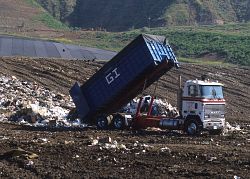

In the Commissioners for Her Majesty's Customs and Excise v Devon Waste Management Limited, Biffa Waste Services Limited, Veolia ES Landfill Limited, Veolia Cleanaway (UK) Limited, the HMRC were appealing a decision over liability to pay landfill tax on the disposal of certain waste materials.
Selected waste materials, known as ‘fluff’ and EVP are used by waste operators in landfill sites to protect the lining membrane of landfill cells. This appeal focused on whether the use of this ‘fluff’ amounted to disposal of waste materials for the purposes of the Finance Act 1996, and therefore was subject to landfill tax.
In the Finance Act 1996, if there is a disposal of material as waste, it is taxable. This means, under section 64, ‘if the person making the disposal does so with the intention of discarding the material’. Each of the site operators in this case did use the ‘fluff’ in their landfill waste operations, but the key question was – is this material disposed of as waste?
The First-Tier Tribunal originally held that the disposal of ‘fluff’ did amount to waste, so landfill tax was chargeable. This decision was then reversed on appeal by the waste companies to the Upper Tribunal, who ruled that in fact the waste companies were using the ‘fluff’ and EVP in their landfills to protect its structure, therefore they didn’t have intention to discard it and consequently it was not taxable. The HMRC then appealed this decision.
In establishing whether the use of this ‘fluff’ and EVP did amount to intention to discard the material, the court set out a non-exhaustive list of relevant factors relevant to consider. These included whether the material was being placed somewhere within the landfill’s perimeter but not in the cell itself. If the material was put in the cell immediately or soon after its arrival at site or if it was separated out from the main body of waste and stored. They also considered if the material was put in the cell with an expectation that it would remain there permanently, as well as the circumstances surrounding the acquisition of the material.
When considering all those factors it was important to remember that it is not true that once something is classed as waste it is always waste. In the First-Tier Tribunal they had noted that the ‘fluff’ was the exact same material as in other black bag waste which was later added into the landfill as part of the general body of waste, so any ‘fluff’ surplus to requirements in terms of cell lining would simply be disposed of as waste. This was a relevant point. However, the First-Tier Tribunal also highlighted an important distinction that was a relevant factor - the processing of the ‘fluff’ material. In other cases, the material was processed and transformed separately by the landfill site operator before being used as ‘fluff’. The court ruled that the absence of any such processing in this case was relevant.
The Court also considered the interpretation of section 64 of the Finance Act 1996 in relation to deciding if there was the intention to discard the material. The way in which the waste operators in this case used the ‘fluff’ and EVP did not in itself negate their obvious intention to discard the material.
It was argued that the companies were disposing of the materials as waste, but doing so in a careful manner, placing it into the cells in a way to prevent damage to the infrastructure of the cell and reduce the likelihood of future problems with the cell once capped and sealed. Arguably this was disposal of the materials and consequently a taxable deposit.
Some authorities when applying the legislation on landfill tax had considered synonyms for ‘discard’ as well as antonyms (‘retention’ and ‘use’), in trying to come to a decision on the provisions. Although this could be helpful the court ruled it shouldn’t divert attention from the term ‘discard’ in its legislative context. They said the First-Tier Tribunal had applied the statutory question as set out in the Finance Act 1996, and came to the right answer.
The Court also considered its judgment in its decision in Waste Recycling Group Ltd V Revenue and Customs Commissioners 2008. This decision was informed on the facts of the case and no elaboration of the definition in the words of section 64 of the Finance Act 1996. The judgment in that case did not support that any use of the material ruled out an intention to discard it. In fact, there was no support for that premise in case law or decisions taken by authorities.
In this appeal, the Court focused on the statutory question – did the respondents dispose of the ‘fluff’ or EVP as waste because they disposed of it with the intention of discarding it. They decided to allow the HMRC’s appeal, concluding that there was intention to dispose of the ‘fluff’ and EVP as waste, regardless of its placing in the landfill cells done in such a way to protect them. Therefore, the companies were liable to pay landfill tax on these materials.